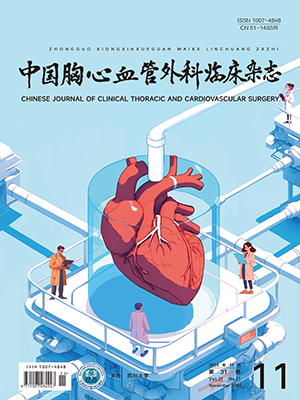| 1. |
Presbitero P, Aruta E, Rabajoli F, et al. Aortic dissection after aortic valve replacement:clinical and anatomic features. G Ital Cardiol, 1992, 22(8):941-947.
|
| 2. |
Demirtas S, Osken A, Vatan MB, et al. Asymptomatic aortic dissection late after aortic valve replacement. Maedica (Buchar), 2012, 7(2):177-179.
|
| 3. |
Natsuaki M, Itoh T, Rikitake K, et al. Aortic complications after aortic valve replacement in patients with dilated ascending aorta and aortic regurgitation. J Heart Valve Dis, 1998, 7(5):504-509.
|
| 4. |
Enseleit F, Grünenfelder J, Braun J, et al. Formation of pseudoaneurysm after aortic valve replacement without previous endocarditis:a case-control study. J Am Soc Echocardiogr, 2010, 23(7):741-746.
|
| 5. |
Bruce W, Andrus, MD, Daniel J, et al. Stability of ascending aortic dilatation following aortic valve replacement. Circulation, 2003, 108 (Suppl 1):Ⅱ295-Ⅱ299.
|
| 6. |
Modi A, Vohra HA, Kaarne M, et al. Long-term outcome following repair of acute type A aortic dissection after previous cardiac surgery. Interact Cardiovasc Thorac Surg, 2011, 13(4):386-391.
|
| 7. |
Hiratzka LF, Bakris GL, Beckman JA, et al. 2010 ACCF/AHA/AATS/ACR/ASA/SCA/SCAI/SIR/STS/SVM Guidelines for the diagnosis and management of patients with thoracic aortic disease. J Am Coll Cardiol, 2010, 55(14):e27-e129.
|
| 8. |
Rajamannan NM, Evans FJ, Aikawa E, et al. Calcific aortic valve disease:not simply a degenerative process:A review and agenda for research from the National Heart and Lung and Blood Institute Aortic Stenosis Working Group. Executive summary:Calcific aortic valve disease-2011 update. Circulation. 2011, 124(16):1783-1791.
|
| 9. |
Picchi A, Focardi M, Capannini G, et al. Aortic dissection after aortic valve replacement-a case report and literature review. Angiology, 2003, 54(6):715-719.
|
| 10. |
Matsuyama K, Usui A, Akita T, et al. Natural history of a dilated ascending aorta after aortic valve replacement. Circ J, 2005, 69(4):392-396.
|
| 11. |
Tsutsumi K, Inoue Y, Hashizume K, et al. Risk factor analysis for acute type A aortic dissection after aortic valve replacement. Gen Thorac Cardiovasc Surg, 2010, 58(12):601-605.
|
| 12. |
von Kodolitsch Y, Simic O, Schwartz A, et al. Predictors of proximal aortic dissection at the time of aortic valve replacement. Circulation, 1999, 100(19 Suppl):Ⅱ287-Ⅱ294.
|
| 13. |
von Kodolitsch Y, Loose R, Ostermeyer J, et al. Proximal aortic dissection late after aortic valve surgery:119 cases of a distinct clinical entity. Thorac Cardiovasc Surg, 2000, 48(6):342-346.
|
| 14. |
Collins JS, Evangelista A, Nienaber CA, et al. Differences in clinical presentation, management, and outcomes of acute type a aortic dissection in patients with and without previous cardiac surgery. Circulation 2004, 110(11 Suppl 1):Ⅱ237-Ⅱ242.
|
| 15. |
Estrera AL, Miller CC, Kaneko T, et al. Outcomes of acute type a aortic dissection after previous cardiac surgery. Ann ThoracSurg, 2010, 89(5):1467-1474.
|
| 16. |
Gillinov AM, Lytle BW, Kaplon RJ, et al. Dissection of the ascending aorta after previous cardiac surgery:differences in presentation and management. J ThoracCardiovascSurg, 1999, 117(2):252-260.
|
| 17. |
Kirsch EW, Radu NC, Mekontso-Dessap A, et al. Aortic root replacement after previous surgical intervention on the aortic valve, aortic root, or ascending aorta. J Thorac Cardiovasc Surg, 2006, 131(3):601-608.
|
| 18. |
Schepens MA, Dossche KM, Morshuis WJ. Reoperations on the ascending aorta and aortic root:pitfalls and results in 134 patients. Ann Thorac Surg, 1999, 68(5):1676-1680.
|
| 19. |
Sugiura T, Imoto K, Uchida K, et al. Comparative study of brain protection in ascending aorta replacement for acute type A aortic dissection:retrograde cerebral perfusion versus selective antegrade cerebral perfusion. Gen Thorac Cardiovasc Surg, 2012, 60(10):645-648.
|
| 20. |
Rylski B, Beyersdorf F, Blanke P, et al. Supracoronary ascending aortic replacement in patients with acute aortic dissection type A:what happens to the aortic root in the long run? J Thorac Cardiovasc Surg, 2013, 146(2):285-290.
|
| 21. |
Sun LZ, Qi RD, Chang Q, et al. Surgery for acute type A dissection using total arch replacement combined with stented elephant trunk implantation:Experience with 107 patients. J Thorac Cardiovasc Surg, 2009, 138(6):1358-1362.
|




